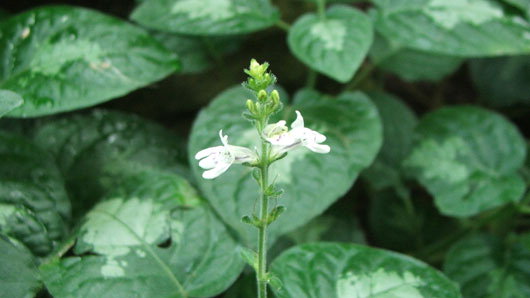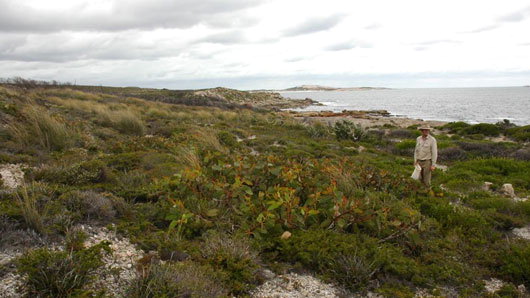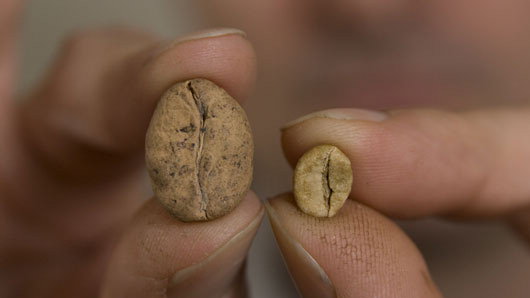UK: Hundreds of new species round-off Kew's anniversary year
22.12.09
It's been a remarkable year for Kew, as it celebrates its 250th year, and as we enter the International Year of Biodiversity in 2010 comes news of over 250 new species discovered by botanists from the famous London garden.
The new finds span the plant kingdom: from fire-resistant Eucalyptus in the Australian scrub to new Coffea in the mountains of Madagascar, giant rainforest trees in Cameroon to a tiny Isoetes in South Africa.
But perhaps most astonishing was the discovery - or re-discovery - of a member of the Acanthaceae family right under the noses, or trowels, of the team in the Princess of Wales Conservatory. Stumbling across the plant, which was being used as bedding material, nearly 100 years after it was first found, Dr Iain Darbyshire, an expert on the Acanthaceae, realised it was something special. The team rummaged around in the herbarium and found specimens collected in 1950 by the eminent East African botanist Dr Bernard Verdcourt and these were emblazoned with the plea 'NAME URGENTLY DESIRED'.

Isoglossa variegata was found being used as bedding in the Princess of Wales
Conservatory by Dr Iain Darbyshire nearly one hundred years after it was first collected
© Iain Darbyshire
Over 50 years later that plea has been answered and so Isoglossa variegata formally enters the scientific record. This story begins to highlight the mammoth task of mapping the global flora, but despite the magnitude and necessity of the task the scientists of Kew and their partner organisations, in over one hundred countries, won't be giving up.
But in this special year even the Director, Stephen Hopper, has been in on the action. Not only has he described two new species of Eucalyptus from his native Australia, but also discovered a tiny quillwort (Isoetes eludens) in a remote temporary rockpool in South Africa.
The first new species Eucalyptus sweedmaniana, named after his colleague Luke Sweedman who shared the discovery, is a dwarf type that survives the seasonal fires by dying back to an underground rootstock, called a lignotuber, from which it can regrow.
 The second
Eucalyptus brandiana (pictured left), is a larger plant but can be killed by fire. Hopper's research showed there are only a couple of hundred individuals and are, probably, in need of urgent conservation, but the fact they have potential in the ornamental industry may help safeguard their future as with Wollemia
nobilis (the Wollemi Pine), an ancient plant, which was only discovered in 1994 one hundred miles outside Sydney.
The second
Eucalyptus brandiana (pictured left), is a larger plant but can be killed by fire. Hopper's research showed there are only a couple of hundred individuals and are, probably, in need of urgent conservation, but the fact they have potential in the ornamental industry may help safeguard their future as with Wollemia
nobilis (the Wollemi Pine), an ancient plant, which was only discovered in 1994 one hundred miles outside Sydney.

Eucalyptus sweedmaniana pictured with Luke Sweedman.
This dwarf species was described by Kew's Director Prof Stephen Hopper
Commercial sales of the Wollemi Pine has helped protect it in the wild and a similar model was used to protect Impatiens gordonii, a Seychelles endemic, of which a hybrid 'Ray of Hope' is sold under the banner 'buy a plant and save the parents'.
Other notable finds by Kew include seven wild coffee species, mostly native to the mountains of northern Madagascar. Recently described new species include Coffea ambongensis and Coffea boinensis, which have the world’s largest ‘coffee beans’, being more than twice the size of those of Coffea arabica (Arabica coffee), the main species used in the commercial production of coffee. And then there are Coffea labatii and Coffea pterocarpa, which have winged fruits, while Coffea namorokensis and Coffea bissetiae are distinctly hairy, a very unusual feature for coffee.
As the world population increases it's becoming increasingly important to protect the genetic diversity of our crop plants. As coffee plantations are very susceptible to 'climate change, pests and diseases', according to Kew, new species could help add robustness to the global industry.

The world’s largest coffee bean Coffea ambongensis (left) with a bean of Arabica coffee
© RBG Kew
Related links:
Explore Kew's new discoveries on their beautiful Interactive Map
Madagascar: Kew team give live updates from the field
17.11.09
 Once upon a time botanical expeditions would have ventured into the unknown, only to return (hopefully) a few months later to a rapturous home-coming as they reveal their results. But conservation is changing and it's largely a result of the rapidly shifting digital landscape.
Once upon a time botanical expeditions would have ventured into the unknown, only to return (hopefully) a few months later to a rapturous home-coming as they reveal their results. But conservation is changing and it's largely a result of the rapidly shifting digital landscape.
Chile IN PICTURES: A conservation adventure
16.11.09
 In March 2009 plant collectors from the UK and Chile set off to hunt for rare and endangered species with the vision of conserving these species for the future.
In March 2009 plant collectors from the UK and Chile set off to hunt for rare and endangered species with the vision of conserving these species for the future.
Chile: A Chilean conservation adventure
13.11.09
 Smoking volcanoes, devastated towns, leech infested forests, endless breathtaking landscapes, and the beautiful but often highly endangered plant species of South America greeted the team from Wakehurst Place, Kew’s country estate in West Sussex, the Forestry Commission's Bedgebury Pinetum and Westonbirt Arboretum.
Smoking volcanoes, devastated towns, leech infested forests, endless breathtaking landscapes, and the beautiful but often highly endangered plant species of South America greeted the team from Wakehurst Place, Kew’s country estate in West Sussex, the Forestry Commission's Bedgebury Pinetum and Westonbirt Arboretum.
Himalayas: Vulnerable new species at mountainous crossroads
10.08.09
 A new report by WWF - The Eastern Himalayas: Where Worlds Collide - describes more than 350 new species living at a geographical and ecological crossroad.
A new report by WWF - The Eastern Himalayas: Where Worlds Collide - describes more than 350 new species living at a geographical and ecological crossroad.